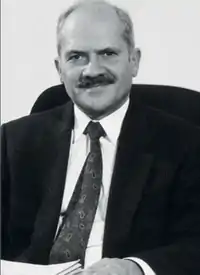Otto Leiberich
Otto Leiberich (* 5 December 1927 in Crailsheim, † 23 June 2015) was a German cryptologist and mathematician.[1][2] Leiberich is most notable for establishing the Bundesamt für Sicherheit in der Informationstechnik in 1991.[3]
Otto Leiberich | |
|---|---|
 Otto Leiberich at his desk. | |
| Born | December 5, 1927 |
| Died | June 23, 2015 (aged 87) |
| Citizenship | German |
| Alma mater | University of Cologne |
| Scientific career | |
| Fields | Mathematics Cryptology |
| Doctoral advisor | Guido Hoheisel |
Life
Leiberich started his career during World War II, conscripted as a soldier and working as a cryptanalyst in Chi IV of the OKW/Chi.[4]
After studying mathematics and physics at the University of Cologne, Leiberich earned a Dr. phil. in 1953 at the same university[5] with a topic on algebra; his thesis (German: "Über Systeme von Jardenschen Folgen", On systems of Jarden sequences) was supervised by Guido Hoheisel. Leiberich joined the newly established post war German cipher bureau that from 1956 on was called the Central Cryptography Office[3] (German: Zentralstelle für das Chiffrierwesen (ZfCh)). Dr Erich Hüttenhain was his director, both in OKW/Chi and in the new bureau.
Career
During the Cold War Leiberich and his team worked intensively on the cryptanalysis of double transposition ciphers. One of their results led in 1974 to the discovery of the spying activities of Günter Guillaume who was senior aide to Willy Brandt, the statesman who served as Chancellor of the Federal Republic of Germany (West Germany) from 1969 to 1974.[6]In 1972, Leiberich was the successor to Erich Hüttenhain as the Head of the Central Cryptography Office.[7]
In 1999, Leiberich wrote a report on the history of cryptography in Germany, which appeared in the international science magazine Spektrum der Wissenschaft.[8]
Cipher challenge
In order to encourage research on the double transposition cipher, Leiberich suggested during his retirement in 1999, that a double transposition challenge be published. Leiberich's recommendation for the challenge included:
- Both transposition keys should be long enough: 20 to 25 elements.
- The lengths of the ciphertext should not be a multiple of the length of either key.
- A ciphertext of approximately 500 characters, i.e. the product of the lengths of the two keys, should be used.
These properties were based on Leiberich's own experience, designed with parameters to ensure its own security[7] In 2007, the challenge was published by Klaus Schmeh,[7] in various media channels inclduding his own books, websites and academic and white papers.[7]
In November 2013, George Lasry, Nils Kopal and Arno Wacker solved the double transposition cipher using a ciphertext only hill climbing attack. They also developed a Dictionary attack that also solved it.[9][10]
Publications
- Leiberich, Otto (1953), Über Systeme von Jardenschen Folgen, Hochschulschrift Köln, Phil. F., Diss. v. 9. Okt. 1953 (in German), Köln
- Leiberich, Otto (June 1999), "Vom diplomatischen Code zur Falltürfunktion – Hundert Jahre Kryptographie in Deutschland", Spektrum der Wissenschaft (6): 26–34
References
- Laux, Hans (2015), "Otto Leiberich, Kryptomathematiker und Freund", Trilogie meines Lebens: Erinnerungen eines Aktuars (in German), Karlsruhe: Verlag Versicherungswirtschaft, pp. 128–136, ISBN 978-3-89952-902-9
- Literature by and about Otto Leiberich in the German National Library catalogue
- Hange, Michael (15 December 2015), "Obituary for Dr Otto Leiberich" (PDF), Security in Focus – BSI Magazine 2015, Bundesamt für Sicherheit in der Informationstechnik, 2015: 42–43 [22], retrieved 22 January 2019
- The Enigma Bulletin, Source:British Archives document:ADM 223/505. Enigma Press. 1997. p. 78. Retrieved 13 June 2018.
- Laux, Hans (2015), "Otto Leiberich, Kryptomathematiker und Freund", Trilogie meines Lebens: Erinnerungen eines Aktuars (in German), Karlsruhe: Verlag Versicherungswirtschaft, p. 130, ISBN 978-3-89952-902-9
- Lasry, George (2018), A Methodology for the Cryptanalysis of Classical Ciphers with Search Metaheuristics, Kassel: kassel university press, p. 175, doi:10.19211/KUP9783737604598, ISBN 978-3-7376-0458-1
- Friedrich L. Bauer (24 November 2006). Decrypted Secrets: Methods and Maxims of Cryptology. Springer Science & Business Media. p. 415. ISBN 978-3-540-48121-8. Retrieved 12 June 2018.
- Leiberich, Otto (1 June 1999). "Vom diplomatischen Code zur Falltürfunktion". Spektrum der Wissenschaft (in German). Spektrum der Wissenschaft Verlagsgesellschaft mbH. Retrieved 13 June 2018.
- Lasry, George; Kopal, Nils; Wacker, Arno (November 2013). "Solving the Double Transposition Challenge with a Divide and Conquer Approach" (PDF). Retrieved 12 June 2018. Cite journal requires
|journal=(help) - Lasry, George; Kopal, Nils; Wacker, Arno (2014). "Solving the Double Transposition Challenge with a Divide-and-Conquer Approach". Cryptologia. Taylor & Francis. 38 (3): 197–214. doi:10.1080/01611194.2014.915269. S2CID 7946904.